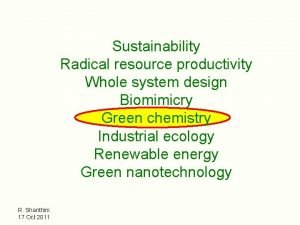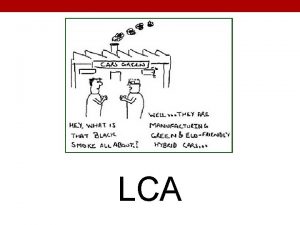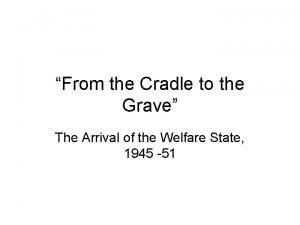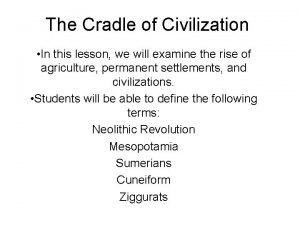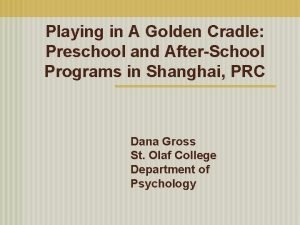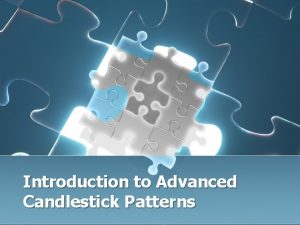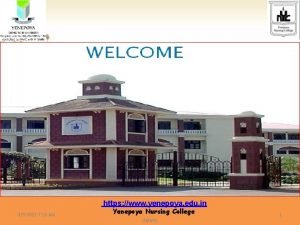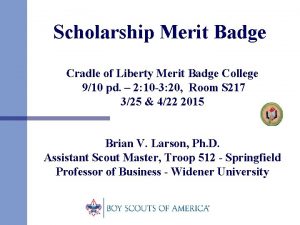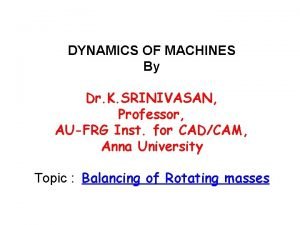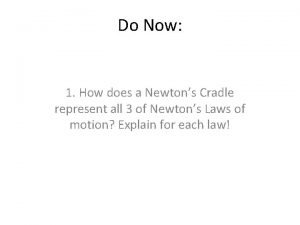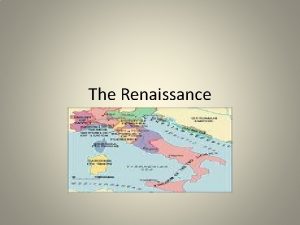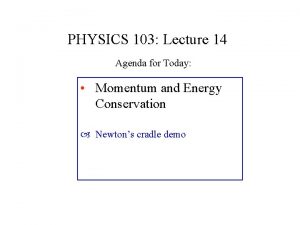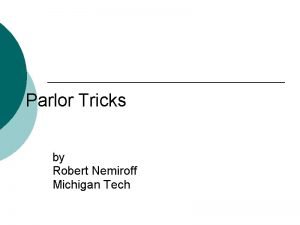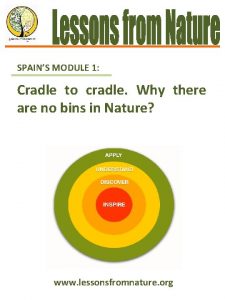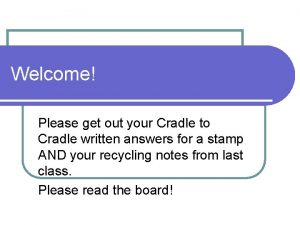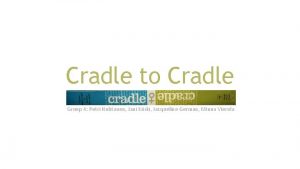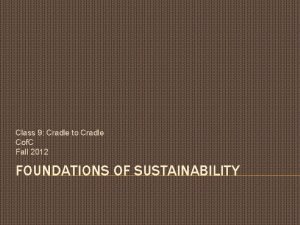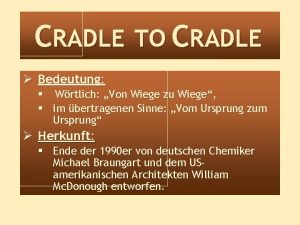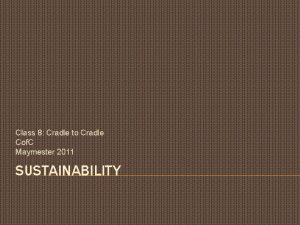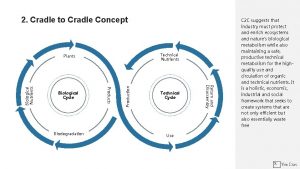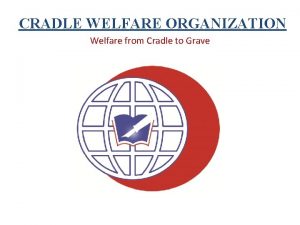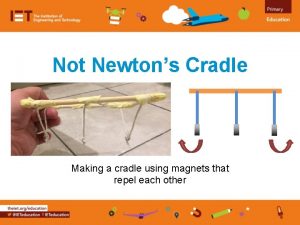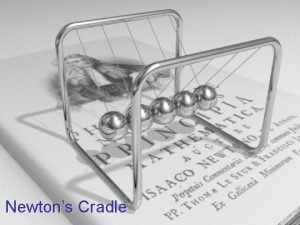MODULE 1 Cradle to cradle Why there are




















- Slides: 20

MODULE 1: Cradle to cradle. Why there are no bins in Nature? www. lessonsfromnature. org/es

MODULE 1: Cradle to cradle. Why there are not bins in Nature? Lf. N principles: Nature optimizes (within the limits). Waste = food. Nature provides multiple benefits. General objectives: • Understanding how nature deals with wastes • Discovering circular economy • Analysing the weaknesses and strengths of a circular economy process by comparing it to a lineal production process • Applying the circular economy concept when designing products

Abstract This module develops the concept of waste=food and circular economy. Linear and circular economies are compared, allowing critical analysis of "cradle to grave" and "cradle to cradle" paradigms. We will analyse the life-cycle of a manufactured food product, studying the environmental impacts that produces during the extraction of the raw materials from nature to the disposal phase. Later, we will study how nature produces food, analysing any fruit or seed raised in nature. Afterwards, we will discuss how we can apply the insights learned from nature to human production of goods and services: circular economy. Expected changes: • Developing critical thinking using circular economy. • Exploring circular economy models using food products as examples.

Competencia matemática: • Cálculos sobre la huella ecológica. • Estimación de los “kilómetros de alimentos”. Competencia en el conocimiento y la interacción con el mundo físico: • Investigación comparativa sobre la cadena de producción de un alimentos frescos y procesados. • Análisis del ciclo de un producto natural dentro del ecosistema. Competencia social y ciudadana: • Comprender el funcionamiento de las cadenas de producción, distribución, consumo y deshecho. • Explorar las implicaciones técnicas y sociales de dicha cadena (infraestructuras de transporte, energía, organización, etc. ) Competencia en comunicación lingüística: • Conseguir información sobre el ciclo de vida de un producto alimenticio. • Comunicar oralmente y por escrito los resultados de las investigaciones y sus conclusiones.

Autonomía e iniciativa personal: • Iniciación al pensamiento crítico. • Investigar sobre cómo un alimento llega a nuestra mesa y los distintos caminos que puede seguir después. • Iniciativa para la búsqueda de soluciones colectivas. Enfoque didáctico Las actividades que se detallan en la planificación de lecciones han sido concebidas desde un enfoque constructivista del aprendizaje, siguiendo cuatro etapas: INSPIRA, DESCUBRE, COMPRENDE y APLICA. Presentación Prezi del módulo.

1. INSPIRA En la primera sesión se busca estimular y captar la atención del alumno para motivar su necesidad de adquirir nuevas capacidades y conocimientos. 2. DESCUBRE El alumno se enfrenta a una cuestión que desconoce y para resolverla tendrá que acudir a distintas fuentes (bibliografía, investigación de campo, entrevistas). El profesor guiará el aprendizaje para mostrar usando la naturaleza como mentora. 3. COMPRENDE Se aplicarán los métodos iniciales de investigación a un caso concreto de sistema que opere de forma análoga a la naturaleza. 4. APLICA En una cuarta fase, dejaremos libertad a la creatividad para aplicar las capacidades adquiridas en los pasos anteriores para resolver problemas reales análogos

Las lecciones están concebidas a modo “catalejo”: pueden expandirse o para poder encajarlas a cada situación concreta y sistema educativo. No es necesario salir del aula para observar los sistemas naturales propuestos, pues se trata de experimentos que se pueden realizar dentro del aula, pero se intenta fomentar las lecciones fuera del aula Se plantean actividades para distintos niveles educativos, pero cada módulo está enfocado a estudiantes de una determinada edad. Los módulos generalmente requieres la intervención de varios profesores, dada su carácter interdisciplinar, aunque puede ser desarrollado dentro de una sola asignatura.


Why there are no bins in nature? As a starting point, there are some interesting videos to watch: KEY COMPETENCES • Observation • Critical Thinking • Analysis • • • EXPECTED OUTCOMES • Make students wonder where our stuff comes from and where does it go after we use it • Getting to know about circular economy underlying mechanisms Fruit break down (http: //bit. ly/o. M 7 G 7 N) Rabbit decomposition (http: //bit. ly/Ihdps 7) Forest dynamics (http: //bit. ly/Ii. Yz 5 H The life cycle of a funghi in 1 minute (http: //bit. ly/IP 5 FRU) Get loopy (http: //bit. ly/IJHXDe) Then, we can discuss about how nature works: • Why there are not bins in nature? • Why humans do need them? • Where does our stuff come from? Learning wall After inspire activity, students should assess their competence levels using the Learning wall (see Anexo 4 in the Spanish version).

Cradle to grave First, teacher should select an industrially processed food product (frozen chips, for example). • • • KEY COMPETENCES Critical thinking Comprehension of a simple product economy cycle Observe how markets work Creativity Math calculations Teamwork EXPECTED OUTCOMES • Development of critical thinking using a simple example of linear economy • Getting to know human produce stuff • Finding out about the consequences of consuming local vs overseas products • Realising about the consequences of producing nonbiodegradable materials Second, students will answer questions like those: 1. 2. 3. 4. 5. 6. 7. 8. 9. 10. 11. 12. Where this food was collected/produced? Where it was processed? How it was processed? Was it packed? What type of package? How did it arrive to the place where you bought it? What pathway did it follow? What is the price per kilogram? How did it arrive to home? How do we store it at home? How do we cook it? What do we do with wastes it generates? How do we handle these wastes? In relation with the price we paid for the product, does it account the actual whole cost of the product (i. e. , production, transport, waste management, etc. )? In negative case, which costs were not included?

As an overall activity, students will design a presentation (poster/slides) displaying the life cycle of that product. This scheme may include the energy/material inputs and outputs (wastes), together with the geographical pathway from production to disposal. Students will also estimate the length of this pathway and the CO 2 equivalent emissions. Students will prepare a report showing the results and conclusions of their research. Cradle to grave Now we will study a natural example of food product that nature “puts in the market”: pine cone seeds (we can select other “products” as berries for example). Squirrels, mice and birds are the potential consumers of these seeds. They must pay a price for that, as long as they spread seeds to areas that are unreachable for the mother tree. Wastes are recycled providing nutrients to soil. All this process happens in short distances. As in the previous unit, we will analyse the inputs and outputs during the product life-cycle.

During the field work we will make some observations as: • Product (berry, fruit, etc. ) • Producer (plant, shrub, tree) • Product description (form, presentation, taste, color, etc. ) • Product consumers • “Wastes” of the product once consumed (give details of who has consumed) • Distribution of the producer individuals (age, sex, position, etc. ) Then, we will be able to answer some questions similar to the Cradle to Grave case. 1. Where does this food come from? 2. Where was “processed”? 3. How it was “processed”? 4. Was it packed? What type of package? 5. How did it arrive to the place where you bought it? What pathway did it follow? 6. How much distance there is between the places of production and consumption/use? And the place where waste was dumped? 7. Could a consumer from a distant country have access to this product? At what price? 8. Would the producer be interested in carrying its product to a distant country? At what price?

9. 10. 11. 12. What is the price paid by the consumer for that product? What was the benefit for the consumer? Was it a fair price/trade? How did the product reach the consumer? How much distance does it travel before being consumed? 13. Was it stored? How? 14. What happened to its wastes? As an overall activity, students will design a presentation (poster/slides) displaying the life cycle of that product. This scheme may include the energy/material inputs and outputs (wastes), together with the geographical pathway from production to disposal. We will emphasize that the process is cyclical (circular economy). Students will prepare a report showing the results and conclusions of their research.

Imitating Nature: cradle to cradle • • KEY COMPETENCES Critical thinking Comprehension of a simple product circular economy cycle Observe how markets work imitating Nature systems Creativity Debate Math calculations Teamwork EXPECTED OUTCOMES • Understanding how human economy can imitate nature's by moving from a linear to a circular economy • Realizing about the benefits of the circular economy model • Reflecting about local production and consumption and the reduction on our impact on nature Just a simple example of circular economy: the lineal cycle of the product analysed first in “Cradle to Grave”, has been modified into a circular one attempting to imitate Nature. We will visit a local producer of potatoes (better if organic) to see how crops are grown. We will follow the product pathway to the local market, where it is sold fresh and nonprocessed. After consumption, wastes are recycled into compost that returns to the soil. The Circular Economy video may help: http: //bit. ly/n. MAOa. U. As before we will analyse inputs and outputs within the product life-cycle and its impacts on the environment, society and economy. We will compare both results. Students will answer the same questions formulated in the Cradle to Grave case. Again we will design a presentation displaying the product life cycle. This scheme may include the geographic pathway from production to disposal, indicating the energy/material inputs and outputs at each step. Students will also estimate the length of this pathway and the CO 2 equivalent emissions.

Finally, we will compare the posters “Cradle to Grave” and “Cradle to Cradle”, and then discuss about advantages and disadvantages of each system.

Applying circular economy • • • KEY COMPETENCES Creativity Entrepreneurship Autonomy Teamwork Technical design Organization EXPECTED OUTCOMES • Applying circular economy concepts in system designing • Finding out about the economical and environmental benefits of being efficient • Looking for collaboration when design a project Now is time to apply the new capabilities we have learned to solve real problems: first, we will choose a product, something simple (a pen, notebook, t-shirt…) to research the product life cycle and, second, we will redesign it into a circular one. Make a Prezi (www. prezi. com) to show your results to your community. The upcycled greenhouse The last lesson illustrates how our wastes can be transformed in profitable goods while pollution is reduced (upcycling). For this part, we can use a comprehensive and practical activity, where students must build a greenhouse using mainly urban wastes. The first step would be the greenhouse design: students should look for a localisation to put the greenhouse and make an inventory of the required resources.

Students should obtain the required resources from typical wastes produced at homes or supermarkets aiming to minimise the cost and to maximise the waste uptake. Lately, students will grow and collect the crops to sell them or to organize a collaborative lunch/dinner at school. Urban crops (to share) Design a project to set urban crops in some spots of your town/city. Make a research about some similar projects, produce a video presentation of the whole process, a show it to your community at any social local centre. Furthermore, you can submit a project to the Local authority to develop some communitarian composting facilities or to rescue urban green spots with organic gardening (www. ortdipace. org). Let's make home-made laundry soap (to share) Students will research how to make soap using human wastes (olive oil: http: //bit. ly/IAraq. E, sunflower oil or any other substance that allow saponification). Then, they can organise the way to obtain the materials and produce a little company of home-made soap.

Let’s make compost (to share) A suggested activity to share and disseminate results, we will build and maintain a compost log. Videos where you can see how to do it: http: //bit. ly/Jwwp. Xf and http: //bit. ly/IPy. TP 2. It’s quite simple. Then we will invite the community to use it to dispose organic waste. Students can design a project, a dissemination plan and a presentation to explain to their parents, families and neighbours how to organise this activity. Furthermore, students can briefly talk about circular economy.

Learning assessment Reflection questions At this point, student should answer the reflection questions proposed in the Anexo 6. These questions together with any others that teacher consider useful and appropriate can be used to assess the learning process. Learning wall Finally, students should re-assess their competence levels using the Learning wall (see Anexo 4 in the Spanish version).

El proyecto Lecciones de la Naturaleza ha sido cofinanciado por la Unión Europea (Comisión Europea, DG "Educación y Cultura" - Programa de aprendizaje permanente/Comenius), con la participación de STERM. La UE no se hace responsable del contenido de estos materiales educativos. Disclaimer: These are beta versions of the Spanish Modules. They have been uploaded to be used at bilingual schools. Some adjustments may be required to adapt the modules to the different school or lesson particularities. Please, have a look to the Spanish anexes and use/translate the materials you consider necessary to develop the module.
 Insidan region jh
Insidan region jh Radical resource productivity
Radical resource productivity Cradle to grave cradle to gate
Cradle to grave cradle to gate Bedankt
Bedankt Cradle to cradle
Cradle to cradle Hey bye bye
Hey bye bye What are the influences of rizal during his childhood
What are the influences of rizal during his childhood Dont ask why why why
Dont ask why why why C device module module 1
C device module module 1 The cradle of civilization
The cradle of civilization Golden cradle kindergarten
Golden cradle kindergarten Fry pan bottom pattern
Fry pan bottom pattern Conclusion of comfort devices
Conclusion of comfort devices Week of peace things fall apart
Week of peace things fall apart Scholarship merit badge
Scholarship merit badge Dynamics of machines
Dynamics of machines Newton's cradle drawing
Newton's cradle drawing Leg cradle to lateral lunge
Leg cradle to lateral lunge Cradle of the renaissance
Cradle of the renaissance Newton's cradle
Newton's cradle Newton's cradle tricks
Newton's cradle tricks

